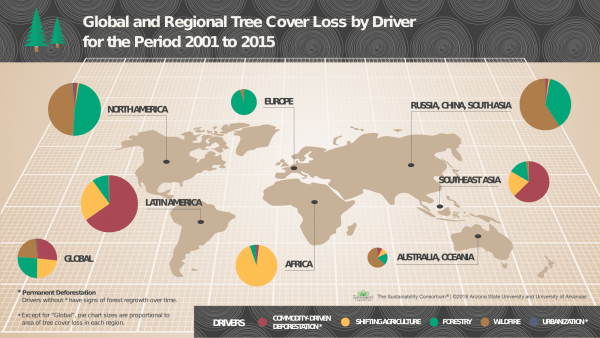Gone for Good? Classifying Drivers of Global Forest Loss
Geographical Sciences research attributes 27% of global forest loss to permanent land use change for commodity production
New research from the University of Maryland Department of Geographical Sciences reveals that more than a quarter of the forests lost around the world in the last 15 years are gone for good. Without significant changes to land management policies and corporate supply chains, the rate of commodity-driven deforestation is not likely to decline in the future.
Alongside colleagues from the University of Arkansas-based Sustainability Consortium and the World Resources Institute, UMD researchers used satellite imagery to develop a forest loss classification model and assign a driver of forest loss for each 10x10 km parcel of land globally between 2001 and 2015. Their findings, published September 14 in Science, show that 27 percent of global forest loss can be attributed to permanent land use conversion for the production of commodities such as palm oil, mining or energy infrastructure. Urbanization is another form of semi-permanent forest conversion, but it was estimated to account for less than 1 percent of global forest loss. The remainder of the forests were lost to things like shifting cultivation, forestry and wildfire—scenarios in which eventual forest regrowth remains possible.
“It’s important to note that not all forest loss is necessarily permanent,” said Alexandra Tyukavina, a post-doctoral associate with the UMD Department of Geographical Sciences and a co-author on the study. “However, our work reveals the stark reality that more than a quarter of the forests lost in the last 15 years or so represent deforestation—meaning they are not re-growing any time soon.”
Results also indicate that, despite recent commitments from nearly 450 companies worldwide to end deforestation in their supply chains by 2020, the rate of commodity-driven deforestation did not decline between 2001 and 2015.
“Our findings clearly show that policies designed to achieve zero-deforestation commitments are not being adopted or implemented at the pace necessary to meet 2020 goals,” said UMD Geographical Sciences Professor Matt Hansen, a co-author in the research. “However, we hope our analysis can help international policymakers better understand what is creating changes to forest cover around the world so that we can stop or, at the very least, slow the loss of ecologically important forests in the future.”
The research team is currently working on a more detailed map of forest disturbance drivers to provide better analysis at the national, regional and local levels.
This article was originally published September 14, 2018
https://bsos.umd.edu/featured-content/gone-good-classifying-drivers

Published on Tue, 09/18/2018 - 17:52


